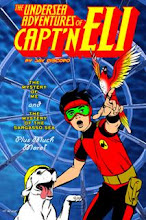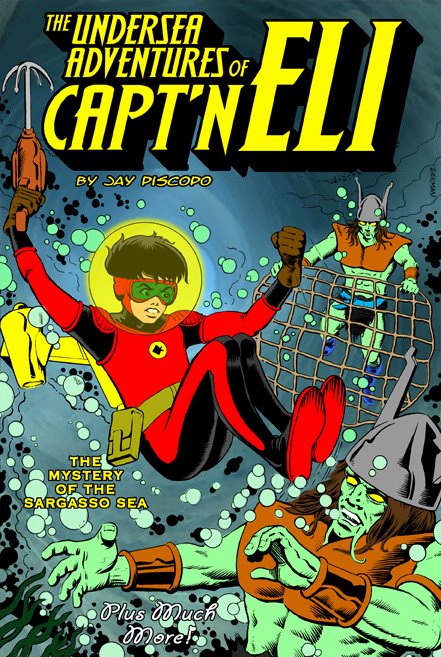“Not only is the art incredible but the stories are well written. This is such a value to our kids." ~ Stephanie McSherry, Literacy Coach, Penn Brook Elementary

Artist and author Jay Piscopo shares tips with Georgetown students
By Theresa DeFranzo/ Correspondent
Wed Nov 18, 2009, 07:03 PM EST
Georgetown, MA - For Jay Piscopo, comic books were his entryway into reading. But since then he’s done much more than just read comics.
Piscopo, the author and illustrator of “The Undersea Adventures of Capt’n Eli,” an all-ages graphic novel series, has been making state-of-the-art children’s entertainment for nearly 20 years. Last week, the Georgetown PTA sponsored an appearance by Piscopo at the Penn Brook School, where he introduced students in grades 2-5 to the art of graphic storytelling.
Piscopo said it was comic books “that got me into reading. Comics are a great way to get kids to read.” The ’40s, he said, were known as the Golden Age of comics and the ’60s and ’70s were the Silver Age. These two periods had the biggest influence on him.
“Batman and the TV show were a huge influence,” he said. “Tarzan was also a big hero of mine.”
To date there are two volumes of “The Undersea Adventure of Capt’n Eli,” with a third volume scheduled to come out next year. According to the author, Capt’n Eli is a graphic novel series in the tradition of Jules Verne, Herge, and classic comic strips like Flash Gordon and Buck Rogers.
With his companions Jolly Roger, a 200-year-old parrot, and the faithful seadog Barney, Capt’n Eli takes readers into a mesmerizing world of time travel, high-tech ships, flying mini-subs, robots, lost civilizations and undersea empires in conflict.
Piscopo’s passion for using the computer as his canvas led him to develop his unique signature style of combining 2D characters with 3D backgrounds.
 What Piscopo did last week with the students was not only talk to them about storytelling, but also show them how to draw — step by step — two famous characters: Dracula and Frankenstein. And for those students who were hesitant to give it a try, Piscopo had this advice for them.
What Piscopo did last week with the students was not only talk to them about storytelling, but also show them how to draw — step by step — two famous characters: Dracula and Frankenstein. And for those students who were hesitant to give it a try, Piscopo had this advice for them.“It doesn’t matter how well you draw,” he said. “It matters how well you get your idea across.”
The great thing about creating just one character is that many more come from it.
“Cartoonists do this all the time,” he said. “They take one character and make more than one from it.”
If you ever find yourself running out of ideas of what to draw, just ask someone to scribble quickly on a blank piece of paper. That’s right — he said you’d be surprised what ideas will come to you using this technique.
After he had a student volunteer scribble for him he said, “I see so many things in this one.”
Stephanie McSherry, literacy coach at Penn Brook, seconded Piscopo’s assertion that graphic novels can help kids get involved in all different kinds of reading.
“I’ve learned over the last year and a half that you can engage kids through graphic novels,” said McSherry. “I got interested last year on how a great piece of artwork and a great story going together can capture a reader.”
She added, “Not only is the art incredible but the stories are well written. This is such a value to our kids. It’s our responsibility to expose our kids to as many different genres as possible.”







